Kanangra and Kirawa
Kanangra and Kirawa were ferries on Sydney Harbour. Both vessels were near identical sister vessels and were launched in 1912 during the early-twentieth pre-Sydney Harbour Bridge boom years of Sydney Ferries Limited.
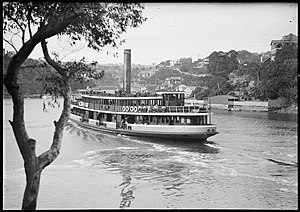 Kanangra in Mosman Bay, 1910s | |
| History | |
|---|---|
| Name: | SS Kanangra (later MV Kanangra) and SS Kirawa |
| Operator: |
Sydney Ferries Limited Sydney Harbour Transport Board Public Transport Commission Urban Transit Authority |
| Port of registry: | Sydney |
| Builder: | Mort's Dock |
| Launched: | 1912 (Kanangra: 14 August) |
| Out of service: | Kirawa 1953, Kanangra 1985 |
| Fate: | Kirawa broken up, Kanangra under restoration |
| General characteristics | |
| Tonnage: | 295 tonnes |
| Length: | 45.7 m |
| Beam: | 9.7 m |
| Decks: | 2 |
| Propulsion: | as built triple-expansion steam. Kanangra Crossley diesel (from 1959) |
| Capacity: | 945 |
They were the first of four steel-hulled "K-class" ferries (the majority of the type were timber-hulled) and they were among the largest of the Sydney Ferries Ltd fleet. Both 45 metres in length and with passenger capacities of over 1,000 passengers each, they mainly served the busy Circular Quay to Milsons Point prior to the opening of the Sydney Harbour Bridge, and later the Cremorne and Mosman routes.
Kirawa was decommissioned in 1953, and Kanangra in 1985. Kanangra is now part of the Sydney Heritage Fleet and is moored at Rozelle Bay undergoing restoration. It is the last remaining ferry built for Sydney Ferries Limited in the early twentieth century pre-Sydney Harbour Bridge peak.
Sydney Ferries Limited generally choose Australian Aboriginal names for the early twentieth "K-class" steamers. "Kanangra" is thought to mean "beautiful view" and "Kirawa" is thought to mean "looking for you".
Background
Kanangra and Kirawa were built for Sydney Ferries Limited during the early twentieth century boom in cross-Harbour travel prior to the 1932 opening of the Sydney Harbour Bridge. At the time, the company ran one of the largest ferry fleets in the world. The two ferries were part of broader type of around 20 double-ended timber screw ferries - the Sydney K-class ferries - that the company commissioned between the 1890s and early 1920s to meet the booming demand.
The two ferries followed the Sydney Ferries Limited convention of naming their vessels after Australian Aboriginal words starting with "K". "Kanangra" is thought to mean "beautiful view" and "Kirawa" is thought to me "looking for you".
Design and construction
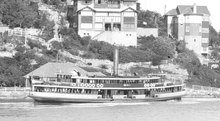
Unlike the previous K-class ferries that were timber-hulled, the near identical Kanangra and Kirawa were riveted steel hull vessels with timber decks and superstructures. Built by Mort's Dock at their Woolwich yard for Sydney Ferries Limited, Kanangra was launched on 14 August 1912 and commissioned in January 1913. Kirawa was also launched in 1912.[1] As built, both vessels were provided with 68-hp triple expansion coal-fired steam engines that pushed them to 13 knots, quite fast for Sydney ferries of that era. As with all the K-class and Manly ferries built at the time, they were double ended ferries with wheelhouses, propellers and rudders at both ends. The two ferries were among the largest and highest-capacity inner-harbour ferries operated on Sydney Harbour with only the Manly ferries and 1922's Kuttabul and Koompartoo being significantly larger.
Service history
As two of the largest ferries in the fleet, Kanangra and Kirawa primarily operated on the most heavily-patronised services; initially the Circular Quay to Milsons Point services until the Harbour Bridge opened in 1932, and then on the worker's services to Cockatoo Island and later Mosman and Taronga Zoo services.[2][3] Demand for ferry services across the harbour were booming in the early 20th century, and in 1911, Sydney Ferries Limited had begun services to the new Cremorne Wharf with new tram connection.
Both Kanangra and Kirawa were kept in service after the 1932 opening of the Sydney Harbour Bridge whereas many vessels were decommissioned due to the drop in demand. Prior to the bridge opening, Sydney Ferries Limited had transported 40 million passengers a year, which dropped to 15 million after the opening. The drop in demand for the remaining ferry fleet, including Kanangra and Kirawa, was somewhat mitigated as many could not afford their own transport in the Great Depression of the 1930s and rationing of fuel during World War 2 made the coal required for the steam ferries relatively cheap.[4]
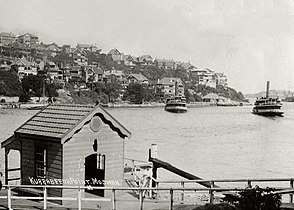
In 1951, as the demand for ferry services dropped further to 9 million following the end of the war, the NSW State Government took over Sydney Ferries Limited and its remaining fleet and assets. The Port Jackson and Manly Steamship Company, which ran the Manly service, was paid to run the services. The services and fleet were quickly rationalised with most of the larger remaining timber K-class steamers being decommissioned. A number of the smaller coal burners were being converted to diesel (including Kameruka and Kosciusko).
Kirawa was laid up at the time in need of a new boiler. As there was no longer need for two large ferries, she was sold to be broken up in 1953. Hulked, she was renamed Demolisher and, along with the stripped-down Manly ferry Balgowlah, was used in the demolition and removal of the old Iron Cove Bridge.[5][6]
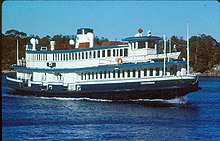
Kanangra was taken out of service in 1951 for a major refit and was returned to service in 1953. She was too costly to replace, indeed, many other surplus ferries were being scrapped. On 1 May 1959, she made her last trip as a steamer on the 5:35 Circular Quay - Mosman - Cremorne run. She was converted to diesel power with a single direct coupled eight cylinder Crossley engine driving a fore and aft propellor. Her tall smoke stack was replaced with a smaller exhaust funnel, and the boilers became the fuel tanks. She was the last of the Sydney Harbour steam ferries to be converted to diesel. The ferry's re-entry to service allowed the last of the coal-fired steamers, Kubu, to be retired.[7]
In June 1964, Kanangra collided with the Japanese freighter Awata Maru off Kirribilli.[8] In November 1984, she collided with the North Head off the Opera House.[9] She participated in the "Great Ferry Boat Race" during the early and mid 1980s.
One of the longest serving ferries on Sydney Harbour,[6] Kanangra was withdrawn from service in 1985 and moored adjacent to the Pyrmont Bridge in Darling Harbour. After plans to restore it as a steam powered vessel as a Bicentennial project were dropped due to high expense, it was donated to the Sydney Heritage Fleet in 1987. The Kanangra Restoration Committee was established in 2001. The Fleet plan a full restoration of Kanangra to her 1960s period retaining the diesel configuration. An ultrasound hull survey was conducted in 2002. An urgent program of hull stabilisation has been completed. As of 2020, she is currently moored in Rozelle Bay.[2] In 2009, she was placed on the Australian Register of Historic Vessels.[10]
Kirawa
 Kirawa in Mosman Bay 1915
Kirawa in Mosman Bay 1915 Kirawa at Mosman Wharf, early 1912-1920 (estimate)
Kirawa at Mosman Wharf, early 1912-1920 (estimate)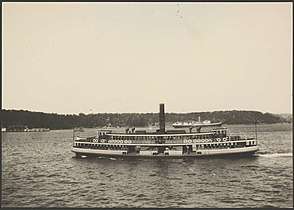 Kirawa approaching Mosman Bay with her original varnished timber and white/grey trim livery, 1920s
Kirawa approaching Mosman Bay with her original varnished timber and white/grey trim livery, 1920s Kirawa in Mosman Bay in her 1930 yellow and green colour scheme, early 1950s
Kirawa in Mosman Bay in her 1930 yellow and green colour scheme, early 1950s Kirawa hulked, renamed Demolisher and used in the demolition of the old Iron Cove Bridge, early 1950s
Kirawa hulked, renamed Demolisher and used in the demolition of the old Iron Cove Bridge, early 1950s
Kanangra
 Kanangra as built on Sydney Harbour
Kanangra as built on Sydney Harbour Kanangra at Sydney Ferries Ltd base in her 1930s yellow and green scheme
Kanangra at Sydney Ferries Ltd base in her 1930s yellow and green scheme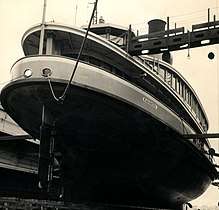 Kanangra in floating dock as a steamer, 1950s
Kanangra in floating dock as a steamer, 1950s Engineer on Kanangra, 1960s
Engineer on Kanangra, 1960s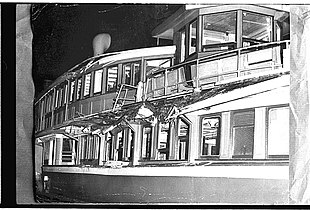 Kanangra damaged in collision with Japanese freighter Awata Maru, June 1964
Kanangra damaged in collision with Japanese freighter Awata Maru, June 1964 Kanangra as a diesel vessel and in her 1960s green and cream Public Transport Commission colours, 1971
Kanangra as a diesel vessel and in her 1960s green and cream Public Transport Commission colours, 1971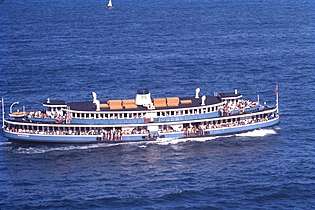 Kanangra in her blue Public Transport Commission colours on a Harbour Cruise, 1970s
Kanangra in her blue Public Transport Commission colours on a Harbour Cruise, 1970s Kanangra, upper saloon, 1970s
Kanangra, upper saloon, 1970s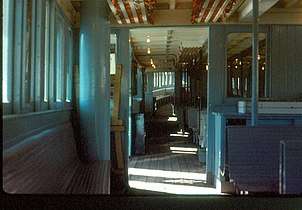 Kanangra, lower deck, 1975
Kanangra, lower deck, 1975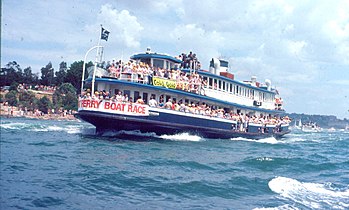 Kanangra in her Urban Transit Authority colours and competing in the first annual Great Ferry Boat Race, 1980
Kanangra in her Urban Transit Authority colours and competing in the first annual Great Ferry Boat Race, 1980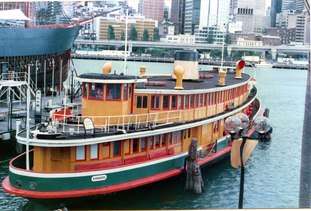 Kanangra as an exhibition vessel in Darling Harbour from late 1980s, with restored 1930s livery.
Kanangra as an exhibition vessel in Darling Harbour from late 1980s, with restored 1930s livery.
See also
References
- Steel Ferry Boat Kanagara Launched Sydney Morning Herald 15 August 1912 page 3
- SS/MV Kanangara Ferries of Sydney
- Sydney Ferry Kanagara Afloat Magazine August 2012
- Kirawa on ferriesofsydney.com
- Kirawa on ferriesofsydney.com
- Andrews, Graeme (1982). A Pictorial History of Ferries: Sydney and Surrounding Waterways. Sydney: AH & AW Reed Pty Ltd. p. 98. ISBN 0589503863.
- Andrews, Graeme (1982). A Pictorial History of Ferries: Sydney and Surrounding Waterways. Sydney: AH & AW Reed Pty Ltd. p. 21. ISBN 0589503863.
- Ferry Damaged In Harbour Collision Canberra Times 24 June 1964 page 29
- Passengers in panic as ferries collide Sydney Morning Herald 6 November 1984
- Kanangra Australian Register of Historic Vessels
- Register of Australian and New Zealand Ships and Boats compiled by Mori Flapan; www.boatregister.net
External links


- Australian Register of Historic Vessels